The global high-current ion implanter market is projected to grow from USD 690.7 million in 2025 to approximately USD 1,114.5 million by 2035, recording an absolute increase of USD 423.8 million over the forecast period. This translates into a total growth of 61.4%, with the market forecast to expand at a compound annual growth rate (CAGR) of 4.9% between 2025 and 2035. The overall market size is expected to grow by nearly 1.6X during the same period, supported by increasing semiconductor device manufacturing demand, rising adoption of advanced chip technologies, and growing focus on precision ion implantation processes for next-generation electronic devices and integrated circuit production.
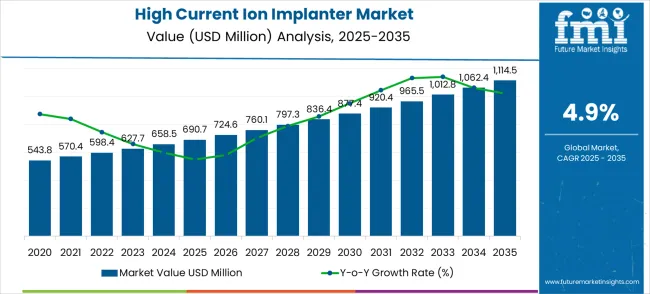
Between 2025 and 2030, the high-current ion implanter market is projected to expand from USD 690.7 million to USD 877.4 million, resulting in a value increase of USD 186.7 million. This phase of development will be shaped by increasing semiconductor fabrication facility expansions, the adoption of advanced node technology, and growing demand for high-throughput ion implantation systems in memory device production and logic chip manufacturing. Ion implanter manufacturers are expanding their high-current system portfolios to address the growing requirements for precise dopant implantation and advanced semiconductor device fabrication.
| Metric | Value |
|---|---|
| Estimated Value in (2025E) | USD 690.7 million |
| Forecast Value in (2035F) | USD 1,114.5 million |
| Forecast CAGR (2025 to 2035) | 4.9% |
From 2030 to 2035, the market is forecast to grow from USD 877.4 million to USD 1,114.5 million, adding another USD 237.1 million, which constitutes 55.9% of the overall ten-year expansion. This period is expected to be characterized by the widespread adoption of advanced semiconductor manufacturing technologies with sub-10nm processes, the integration of artificial intelligence and machine learning in ion implantation control systems, and the development of next-generation implanters with enhanced beam control and process uniformity capabilities. The growing adoption of wide bandgap semiconductors and power device manufacturing will drive demand for high-current ion implanters with improved energy ranges and implantation flexibility.
Between 2020 and 2025, the high current ion implanter market experienced steady development, driven by expanding semiconductor industry growth and growing recognition of the critical importance of precise ion implantation in advanced chip manufacturing and device performance optimization. The market developed as semiconductor manufacturers recognized the potential for high-current ion implanters to enable high-volume production, improve process throughput, and support advanced device architectures requiring precise dopant control. Advanced beam technology and process control systems have begun to emphasize the essential role of ion implantation in enabling semiconductor scaling and performance enhancement.
Market expansion is being supported by the exponential growth of semiconductor device demand and the corresponding need for advanced ion implantation equipment that can support high-volume manufacturing, precision dopant control, and next-generation device architectures in memory, logic, and power semiconductor applications. Modern semiconductor manufacturers are increasingly focused on implantation solutions that provide high throughput, excellent uniformity, and compatibility with advanced process nodes while enabling cost-effective chip production. High current ion implanters' proven ability to deliver precise dopant implantation, production efficiency, and process control makes them essential manufacturing equipment for semiconductor fabrication and electronic device development.
The growing focus on artificial intelligence, 5G technologies, and electric vehicle semiconductors is driving demand for ion implantation equipment that can support advanced chip architectures, power device manufacturing, and specialized semiconductor applications. Manufacturer preference for implantation systems that combine high current capabilities with precise beam control and process flexibility is creating opportunities for innovative high current ion implanter implementations. The rising influence of advanced packaging technologies and heterogeneous integration approaches is also contributing to increased adoption of ion implanters that can provide specialized implantation processes and multi-application capabilities.
The high current ion implanter market represents a mature but essential semiconductor manufacturing equipment opportunity, with the market projected to grow from USD 690.7 million in 2025 to USD 1,114.5 million by 2035 at a moderate 4.9% CAGR—a 61.4% expansion driven by continued semiconductor industry growth and the critical role ion implantation plays in advanced chip fabrication. This specialized equipment enables precise dopant implantation, essential for creating semiconductor junctions and controlling electrical properties in integrated circuits.
The market benefits from the semiconductor industry's relentless scaling demands and increasing complexity of advanced node processes requiring more sophisticated implantation control. Low-energy systems dominate due to their precision capabilities for shallow junction formation in advanced semiconductor devices, while semiconductor applications represent the overwhelming majority of demand. Geographic growth is LED by China (6.6% CAGR), driven by massive domestic semiconductor manufacturing expansion, though overall growth rates remain modest, reflecting the mature nature of this established technology segment.
Pathway A - Low-Energy System Precision Leadership. Advanced semiconductor nodes require ultra-precise shallow junction formation, achievable only through sophisticated low-energy implantation systems. Companies developing next-generation low-energy implanters with enhanced beam control, improved uniformity, and sub-10nm process capabilities will capture the dominant market segment. Expected revenue pool: USD 400-600 million.
Pathway B - Semiconductor Manufacturing Focus. The overwhelming majority of ion implanter demand comes from semiconductor fabrication facilities requiring high-throughput, reliable systems for memory and logic device production. Providers specializing in semiconductor-optimized systems with proven reliability and fab integration capabilities will maintain market leadership. Opportunity: USD 600-900 million.
Pathway C - AI-Driven Process Control and Automation. Next-generation implanters incorporating artificial intelligence for real-time process optimization, predictive maintenance, and autonomous operation enable improved yields and reduced operating costs. Smart systems offering comprehensive fab integration and Industry 4.0 capabilities command premium pricing. Revenue uplift: USD 200-350 million.
Pathway D - Geographic Expansion in China and Asia. China's aggressive semiconductor manufacturing expansion and government support for domestic chip production create substantial opportunities for ion implanter suppliers. Local manufacturing partnerships and technical support capabilities enable market penetration in this high-growth region. Pool: USD 300-500 million.
Pathway E - Advanced Node Technology Support. Sub-10nm semiconductor processes require specialized implantation capabilities with extreme precision and control. Companies developing cutting-edge systems supporting EUV lithography-compatible processes and advanced device architectures will capture premium market segments focused on technology leadership. Expected upside: USD 250-400 million.
Pathway F - Power Semiconductor and Wide Bandgap Applications. Electric vehicle and renewable energy growth drives demand for power semiconductors using silicon carbide and gallium nitride materials, requiring specialized implantation processes. Developing systems optimized for wide bandgap semiconductor manufacturing opens new application segments beyond traditional silicon processing. USD 150-300 million.
Pathway G - Memory Device Manufacturing Optimization. Growing data storage demands drive memory device production, requiring specialized implantation processes for DRAM and NAND flash manufacturing. Systems optimized for high-volume memory production with enhanced throughput and process control serve this critical market segment. Pool: USD 200-350 million.
Pathway H - Service and Retrofit Opportunities. The installed base of ion implanters requires ongoing maintenance, upgrades, and retrofits to support evolving process requirements. Comprehensive service offerings, upgrade packages, and retrofit solutions create recurring revenue streams with strong margins from existing equipment relationships. Expected revenue: USD 100-200 million.
The market is segmented by energy range and application. By energy range, the market is divided into low energy, medium energy, and others. Based on application, the market is categorized into semiconductors, electronic components, and others.
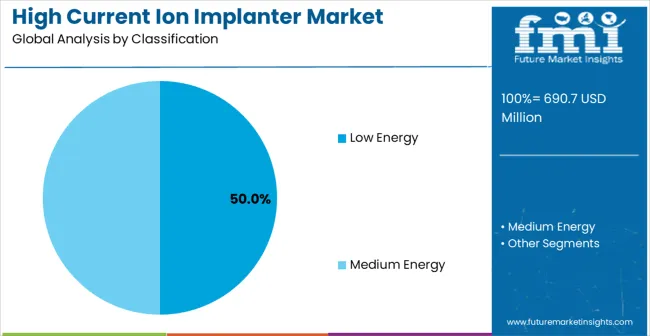
The low energy segment is projected to account 50.0% share for the market in 2025, reaffirming its position as the leading energy range category. Low-energy systems increasingly attract semiconductor manufacturers for their precision implantation characteristics, shallow junction formation capabilities, and suitability for advanced node manufacturing where precise dopant control is critical. Low-energy systems' accuracy and process control directly address the performance and manufacturing requirements for modern semiconductor device fabrication across various technology nodes.
This energy range segment forms the foundation of high-current ion implanter adoption, as it represents the implantation category with the greatest appeal for advanced semiconductor manufacturing requiring precise shallow dopant profiles and excellent uniformity control. Manufacturing investments in advanced node production and device performance optimization strategies continue to strengthen adoption among low-energy system users. With manufacturers prioritizing precision control and advanced process capabilities, low-energy systems align with both technology requirements and production standards, making them the central component of high-current ion implanter market growth strategies.
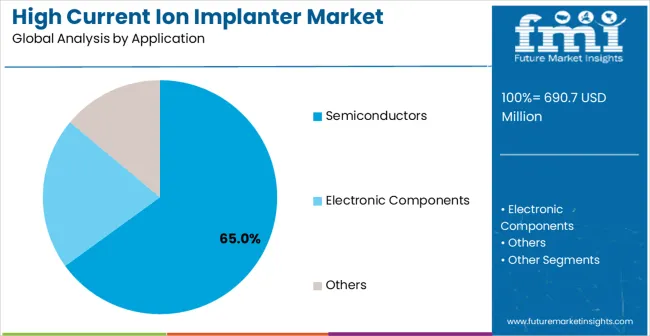
Semiconductors are projected to account 65.0% share for application segment of high-current ion implanter demand in 2025, highlighting their critical role in driving market growth and technology adoption. Semiconductor applications prefer high current ion implanters for their production throughput, process precision, and ability to support advanced chip manufacturing requirements across memory, logic, and analog device production. Positioned as essential fabrication equipment for semiconductor manufacturing, high-current ion implanters offer both production efficiency advantages and process control benefits for semiconductor device fabrication.
The segment is supported by continuous expansion in semiconductor device demand and the growing recognition of the importance of ion implantation, which enables advanced device architectures and performance optimization. Implanter manufacturers are investing in semiconductor-focused solutions to support fab requirements and advanced process node development. As semiconductor technology becomes more advanced and performance-demanding, semiconductors will continue to dominate high-current ion implanter utilization while supporting market expansion and technology advancement.
The market is advancing steadily due to increasing semiconductor manufacturing demands and the growing need for precision ion implantation equipment that supports advanced chip production and next-generation device development. The market faces challenges, including high equipment costs and complex installation requirements, technical complexities associated with beam control and process optimization, and specialized expertise requirements for operation and maintenance. Innovation in beam technology and process automation continues to influence market development and adoption patterns.
The expanding advanced semiconductor manufacturing sector and continuing technology node scaling initiatives are enabling high-current ion implanters to support critical manufacturing processes where conventional implantation equipment cannot provide the throughput, precision, and process control required for high-volume advanced chip production. Semiconductor scaling provides enhanced market opportunities while allowing specialized implantation solutions across various device architectures and manufacturing requirements. Manufacturing organizations are increasingly recognizing the competitive advantages of high-current ion implantation for production efficiency and device performance optimization.
Modern high-current ion implanters are incorporating artificial intelligence-driven process control and advanced automation capabilities to enhance system appeal and address manufacturers' concerns about process optimization, yield improvement, and operational efficiency. These technological enhancements improve implanter value while enabling new market segments, including smart manufacturing applications and autonomous fab operations requiring intelligent process control and predictive maintenance capabilities. Advanced automation integration also allows high-current ion implanters to differentiate from conventional implantation equipment while supporting Industry 4.0 manufacturing and operational excellence initiatives.
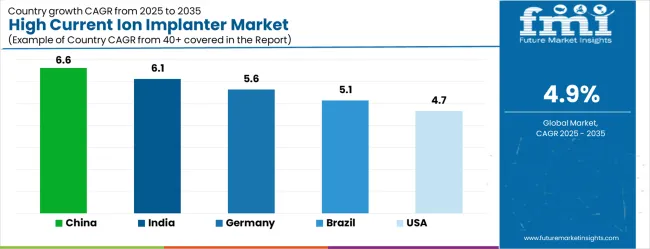
| Country | CAGR (2025-2035) |
|---|---|
| China | 6.6% |
| India | 6.1% |
| Germany | 5.6% |
| Brazil | 5.1% |
| USA | 4.7% |
| UK | 4.2% |
| Japan | 3.7% |
The market is experiencing solid growth globally, with China leading at a 6.6% CAGR through 2035, driven by massive semiconductor manufacturing expansion, comprehensive fab construction programs, and extensive government investment in domestic semiconductor technology development. India follows closely at 6.1%, supported by a rapidly expanding electronics manufacturing sector, increasing semiconductor fab development, and growing adoption of advanced manufacturing technologies. Germany shows strong growth at 5.6%, focusing advanced semiconductor equipment development and comprehensive manufacturing technology programs. Brazil records 5.1%, focusing on electronics manufacturing development and semiconductor technology adoption. The United States shows 4.7% growth, prioritizing semiconductor manufacturing leadership and advanced fabrication technology innovation. The United Kingdom demonstrates 4.2% growth, supported by semiconductor research capabilities and advanced manufacturing initiatives. Japan shows 3.7% growth, prioritizing precision manufacturing excellence and semiconductor equipment innovation.
The report covers an in-depth analysis of 40+ countries; top-performing countries are highlighted below.
China is projected to exhibit exceptional growth with a CAGR of 6.6% through 2035, driven by massive semiconductor manufacturing infrastructure expansion and advancing domestic chip production programs requiring sophisticated ion implantation equipment. The country's leadership in electronics manufacturing and strong government support for semiconductor industry development are creating significant demand for advanced fabrication equipment. Major domestic and international semiconductor equipment manufacturers are establishing comprehensive ion implanter development and production capabilities to serve both domestic fab markets and global semiconductor manufacturing export opportunities.
India is expanding at a CAGR of 6.1%, supported by the rapidly developing electronics manufacturing sector, expanding semiconductor fab initiatives, and increasing adoption of advanced manufacturing technologies among growing technology companies. The country's large electronics market and strong focus on domestic semiconductor production are driving requirements for sophisticated fabrication equipment. International semiconductor equipment companies and domestic manufacturers are establishing comprehensive development and distribution capabilities to address the growing demand for ion implantation systems.
Germany is projected to grow at a CAGR of 5.6% through 2035, prioritizing advanced semiconductor equipment development and comprehensive manufacturing technology programs within Europe's leading precision engineering hub. The country's established semiconductor equipment industry and commitment to technological excellence are driving sophisticated ion implantation equipment requirements. German semiconductor equipment manufacturers and technology companies consistently demand high-precision ion implanter systems that meet stringent semiconductor processing standards and provide superior integration capabilities with advanced fab automation systems.
Brazil is expanding at a CAGR of 5.1% through 2035, focusing on electronics manufacturing development and semiconductor technology adoption across Latin America's emerging technology market. Brazilian organizations value cost-effective manufacturing equipment, operational reliability, and proven performance characteristics, positioning high-current ion implanters as essential equipment for emerging semiconductor manufacturing applications. The country's growing electronics sector and increasing focus on advanced manufacturing are creating constant demand for sophisticated fabrication technologies.
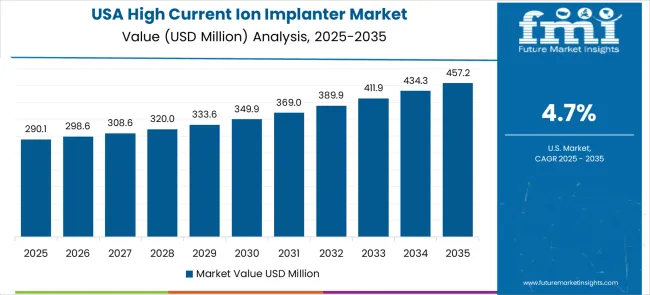
The United States is projected to grow at a CAGR of 4.7% through 2035, driven by semiconductor manufacturing leadership, advanced fabrication technology innovation programs, and established regulatory frameworks supporting cutting-edge semiconductor processing technologies. American companies prioritize technological innovation, process efficiency, and regulatory compliance, making high-current ion implanters a strategic choice for comprehensive semiconductor fabrication applications. The market benefits from mature semiconductor infrastructure and sophisticated equipment technology requirements.
The United Kingdom is expanding at a CAGR of 4.2% through 2035, supported by semiconductor research capabilities, established technology expertise, and growing commitment to advanced manufacturing initiatives and semiconductor strategic capabilities. British organizations value regulatory compliance, technological sophistication, and operational reliability, positioning high-current ion implanters as essential technology for advanced semiconductor research and development applications.
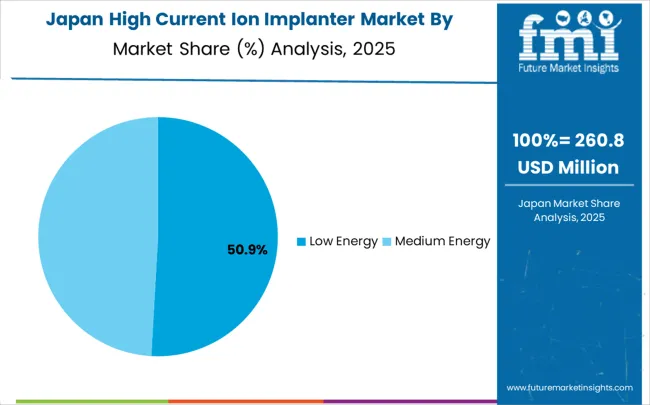
Japan is projected to grow at a CAGR of 3.7% through 2035, prioritizing precision manufacturing excellence, advanced quality control standards, and comprehensive semiconductor equipment innovation aligned with Japanese manufacturing excellence. Japanese organizations prioritize technological precision, process reliability, and long-term operational stability, making high-current ion implanters a strategic choice for premium semiconductor equipment applications. The market is supported by sophisticated semiconductor infrastructure and established precision manufacturing expertise.
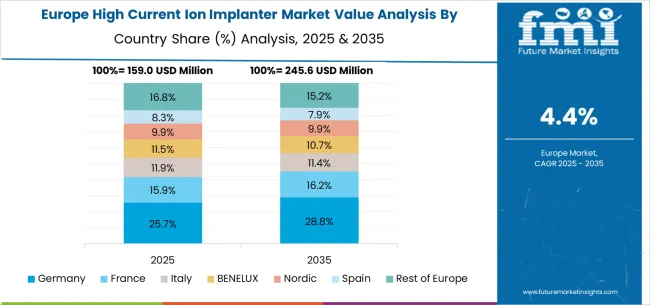
The high current ion implanter market in Europe is projected to grow from USD 176.2 million in 2025 to USD 272.8 million by 2035, registering a CAGR of 4.5% over the forecast period. Germany is expected to maintain its leadership position with a 33.9% market share in 2025, projected to reach 34.7% by 2035, supported by its advanced semiconductor equipment engineering capabilities and comprehensive manufacturing technology programs, including major facilities in Dresden, Munich, and other technology centers.
The United Kingdom follows with a 22.8% share in 2025, projected to reach 23.2% by 2035, driven by comprehensive semiconductor research programs and advanced manufacturing technology development in major technology clusters. France holds an 18.4% share in 2025, expected to reach 18.7% by 2035 due to expanding semiconductor technology development and manufacturing equipment initiatives. Italy commands a 13.6% share, while Spain accounts for 8.1% in 2025. The Rest of Europe region is anticipated to gain momentum, expanding its collective share from 3.2% to 3.5% by 2035, attributed to increasing ion implanter adoption in Nordic countries and emerging Eastern European semiconductor markets implementing advanced manufacturing technologies.
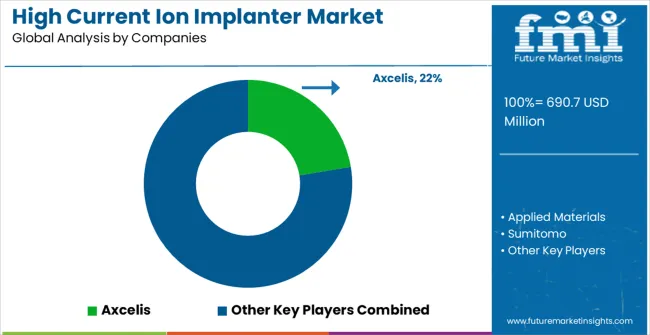
The market is characterized by competition among established semiconductor equipment manufacturers, specialized ion implantation technology providers, and emerging fabrication equipment companies. Companies are investing in advanced beam control technology development, process automation enhancement, throughput optimization, and comprehensive semiconductor fabrication solutions to deliver precise, efficient, and reliable ion implantation systems. Innovation in ion beam technology, process control algorithms, and integration with fab automation systems is central to strengthening market position and semiconductor industry acceptance.
Axcelis leads the market with comprehensive ion implantation solutions, offering advanced high-current systems with a focus on semiconductor manufacturing efficiency and process control excellence. Applied Materials provides integrated semiconductor fabrication equipment with focus on advanced node manufacturing and comprehensive fab solutions. Sumitomo delivers specialized ion implantation technology with a focus on precision control and manufacturing reliability. Nissin Ion Equipment focuses on innovative ion implantation systems with focus on beam technology and process optimization.
SEN Corporation specializes in semiconductor equipment with a focus on Asian market development and manufacturing capabilities. Hwatsing Technology provides ion implantation solutions with focus on cost-effective manufacturing and regional market focus. Additional key players, including Kingstone Semiconductor, Zhongkexin Electronics Equipment, Sifang, Sri Intellectual, and Aien Semiconductor Technology, contribute specialized manufacturing capabilities and technology development across various semiconductor fabrication applications.
| Items | Values |
|---|---|
| Quantitative Units (2025) | USD 690.7 million |
| Energy Range | Low Energy, Medium Energy, Others |
| Application | Semiconductors, Electronic Components, Others |
| Regions Covered | North America, Latin America, Western Europe, Eastern Europe, East Asia, South Asia & Pacific, Middle East & Africa |
| Countries Covered | United States, Canada, United Kingdom, Germany, France, China, Japan, South Korea, Brazil, Australia and 40+ countries |
| Key Companies Profiled | Axcelis, Applied Materials, Sumitomo, Nissin Ion Equipment, SEN Corporation, Hwatsing Technology, Kingstone Semiconductor, Zhongkexin Electronics Equipment, Sifang, Sri Intellectual, Aien Semiconductor Technology |
| Additional Attributes | Dollar sales by energy range and application, regional demand trends, competitive landscape, manufacturer preferences for low versus medium energy systems, integration with semiconductor fabrication processes and automation systems, innovations in beam control technology and process optimization for diverse semiconductor manufacturing applications |
The global high current ion implanter market is estimated to be valued at USD 690.7 million in 2025.
The market size for the high current ion implanter market is projected to reach USD 1,114.5 million by 2035.
The high current ion implanter market is expected to grow at a 4.9% CAGR between 2025 and 2035.
The key product types in high current ion implanter market are low energy and medium energy.
In terms of application, semiconductors segment to command 65.0% share in the high current ion implanter market in 2025.






Our Research Products

The "Full Research Suite" delivers actionable market intel, deep dives on markets or technologies, so clients act faster, cut risk, and unlock growth.

The Leaderboard benchmarks and ranks top vendors, classifying them as Established Leaders, Leading Challengers, or Disruptors & Challengers.

Locates where complements amplify value and substitutes erode it, forecasting net impact by horizon

We deliver granular, decision-grade intel: market sizing, 5-year forecasts, pricing, adoption, usage, revenue, and operational KPIs—plus competitor tracking, regulation, and value chains—across 60 countries broadly.

Spot the shifts before they hit your P&L. We track inflection points, adoption curves, pricing moves, and ecosystem plays to show where demand is heading, why it is changing, and what to do next across high-growth markets and disruptive tech

Real-time reads of user behavior. We track shifting priorities, perceptions of today’s and next-gen services, and provider experience, then pace how fast tech moves from trial to adoption, blending buyer, consumer, and channel inputs with social signals (#WhySwitch, #UX).

Partner with our analyst team to build a custom report designed around your business priorities. From analysing market trends to assessing competitors or crafting bespoke datasets, we tailor insights to your needs.
Supplier Intelligence
Discovery & Profiling
Capacity & Footprint
Performance & Risk
Compliance & Governance
Commercial Readiness
Who Supplies Whom
Scorecards & Shortlists
Playbooks & Docs
Category Intelligence
Definition & Scope
Demand & Use Cases
Cost Drivers
Market Structure
Supply Chain Map
Trade & Policy
Operating Norms
Deliverables
Buyer Intelligence
Account Basics
Spend & Scope
Procurement Model
Vendor Requirements
Terms & Policies
Entry Strategy
Pain Points & Triggers
Outputs
Pricing Analysis
Benchmarks
Trends
Should-Cost
Indexation
Landed Cost
Commercial Terms
Deliverables
Brand Analysis
Positioning & Value Prop
Share & Presence
Customer Evidence
Go-to-Market
Digital & Reputation
Compliance & Trust
KPIs & Gaps
Outputs
Full Research Suite comprises of:
Market outlook & trends analysis
Interviews & case studies
Strategic recommendations
Vendor profiles & capabilities analysis
5-year forecasts
8 regions and 60+ country-level data splits
Market segment data splits
12 months of continuous data updates
DELIVERED AS:
PDF EXCEL ONLINE
High Protein Powders Market Analysis - Size, Share, and Forecast Outlook 2025 to 2035
High Purity Gas Flow Meter Market Size and Share Forecast Outlook 2025 to 2035
High Purity Flow Meter Market Size and Share Forecast Outlook 2025 to 2035
High Performance Permanent Magnet Market Size and Share Forecast Outlook 2025 to 2035
High Airtight Storage Cabinets Market Size and Share Forecast Outlook 2025 to 2035
High Voltage Porcelain Bushing Market Size and Share Forecast Outlook 2025 to 2035
High Purity Process Systems for Semiconductor Market Size and Share Forecast Outlook 2025 to 2035
High Octane Racing Fuel Market Size and Share Forecast Outlook 2025 to 2035
High Voltage Air-cooled Battery Compartment Market Size and Share Forecast Outlook 2025 to 2035
High Temperature NiMH Battery Market Size and Share Forecast Outlook 2025 to 2035
High Security Wedge Barricades Market Size and Share Forecast Outlook 2025 to 2035
High Purity Chemical Filters Market Size and Share Forecast Outlook 2025 to 2035
High Performance Liquid Chromatography-Tandem Mass Spectrometry System Market Size and Share Forecast Outlook 2025 to 2035
High-vacuum Fiber Feedthrough Flanges Market Size and Share Forecast Outlook 2025 to 2035
High Pressure Grease Hose Market Size and Share Forecast Outlook 2025 to 2035
High Performing Matting Agent Market Size and Share Forecast Outlook 2025 to 2035
High Reliability Oscillators Market Size and Share Forecast Outlook 2025 to 2035
High-performance Dual-core Processor Market Size and Share Forecast Outlook 2025 to 2035
High Purity Magnesium Citrate Market Size and Share Forecast Outlook 2025 to 2035
High Performance Magnet Market Size and Share Forecast Outlook 2025 to 2035

Thank you!
You will receive an email from our Business Development Manager. Please be sure to check your SPAM/JUNK folder too.
Chat With
MaRIA